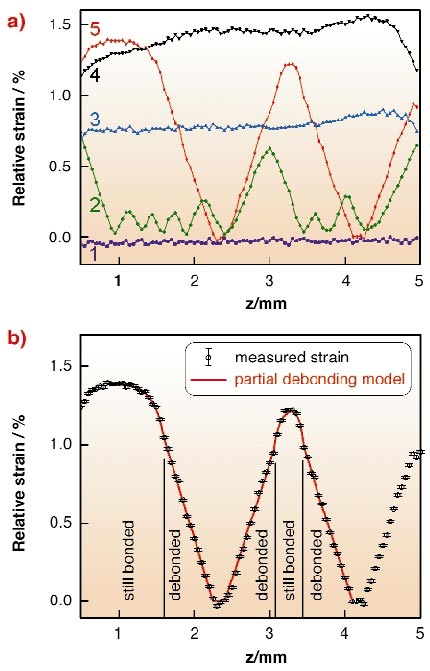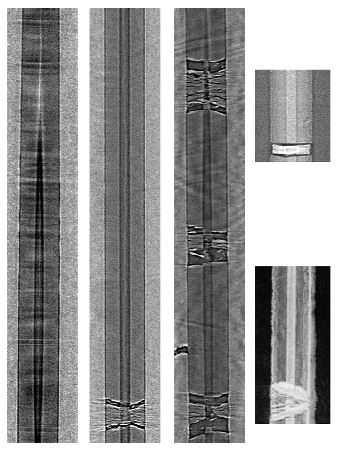- Home
- Users & Science
- Scientific Documentation
- ESRF Highlights
- ESRF Highlights 2003
- Materials Science
- Monitoring the Interface in Metal Matrix Composites
Monitoring the Interface in Metal Matrix Composites
A composite material is much more than just a matrix and a set of fibres. Pivotal to the performance of a composite is the behaviour of the matrix/fibre interface. If too strong, then, once a crack starts to grow in the matrix, it will break all the fibres causing brittle failure. If too weak, then the strength and mechanical properties of the composite will be compromised. This makes it very important to be able to measure the interface properties for a given processing route.
Until recently it has not been possible to measure the properties of the interface directly and as a result experimenters have had to rely on indirect measurements based on micromechanical models.
Our measurements on beamline ID11 have provided the first direct measurements exploiting the highly focused and penetrating beam available there to map the development of strains along the fibres as a function of applied loading. By combining these strain maps with three-dimensional X-ray tomographs collected on beamline ID19 it has been possible to build up a comprehensive picture of the fibre fracture sequence and the associated changes in internal stress.
For these studies a single carbon coated SiC mono-filamentary fibre was embedded in a Ti-6Al- 4V matrix. By straining this composite the fibre breaks into smaller and smaller segments, the lengths of which are determined by the shear sliding strength of the fibre/matrix interface. The elastic strains, as a function of loading, derived from changes in lattice spacing measured by micro diffraction on ID11 are shown in Figure 65a.
 |
|
Fig. 65: a) The variation in axial fibre strain as the applied load is increased; only a few of the loading steps (numbered by increasing load) are shown, b) a fit to the model after two breaks (at 2.3 and 4.1mm). |
As the applied load is increased the fibre strains approximately uniformly until fibre fracture occurs at which point sharp drops in the fibre strain are observed. From the gradients of the resulting slopes the fibre matrix interface strength can be measured accurately (200 MPa). The results of a finite element model simulation are shown in Figure 65b.
It is clear from the figure that the fibre breaks into successively smaller segments and this is confirmed by the virtual section through a 3-D X-ray tomograph, shown in Figure 66. One single and many double cracks were observed in the tomograph. The double cracks occur because of cracks that initiate on the surface of the fibre as a wedge-crack. These appear as double cracks in the slice but their morphology is clearly resolved in the 3-D reconstruction shown in Figure 66.
 |
|
Fig. 66: aTomographic sections taken through the centre of the C-cored fibre before testing, at an intermediate stage, and after full fragmentation. The first core initiated single crack (above) and a 3D semi-transparent visualisation of a wedge-crack (below) are also shown. |
The first single crack initiates from the carbon core of the fibre seen in Figure 66. The elastic shock wave that passes down the fibre causes damage on the surface, which results in the formation of wedge-cracks at much lower loads than were necessary to form the original crack.
In conclusion this work represents the first direct measurements of the interfacial sliding stress for Ti/SiC metal matrix composites. The tomographic images presented here provide the first observation of the formation of wedge-cracks caused by damage initiated at the surface of the fibre. This work is crucial to the development of crack resistant metal matrix composites for applications in aerospace.
References
[1] M. Preuss, P.J. Withers, E. Maire, J.Y. Buffiere, Acta Mater, 50, 3175 (2002).
[2] G. Rauchs, M. Preuss, P.J. Withers, Acta Mater, 50, 2477 (2002).
Principal Publication and Authors
P.J. Withers (a), M. Preuss (a), E. Maire (b), J.-Y. Buffiere (b).
(a) Manchester Materials Science Centre (UK)
(b) GEMPPM, INSA de Lyon (France)



